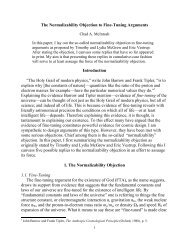Theism and Explanation - Appeared-to-Blogly
Theism and Explanation - Appeared-to-Blogly
Theism and Explanation - Appeared-to-Blogly
Create successful ePaper yourself
Turn your PDF publications into a flip-book with our unique Google optimized e-Paper software.
106 <strong>Theism</strong> <strong>and</strong> <strong>Explanation</strong><br />
In terms of confi rmation theory, the gremlin hypothesis has a low posterior<br />
probability because it has a low prior probability. What is it about the<br />
gremlin hypothesis that gives it a low prior probability? Well, one reason<br />
is that it enjoys little support from our background knowledge: it bears<br />
little relationship <strong>to</strong> those other things which we know <strong>to</strong> be true. So, as<br />
Swinburne is well aware, a key issue is the prior probability of the theistic<br />
hypothesis, <strong>and</strong> a key issue in determining this is the role of background<br />
knowledge. I shall come back <strong>to</strong> these questions shortly (7.2).<br />
We can approach the same question more formally, by way of the Bayesian<br />
reasoning that forms so important a part of Swinburne’s argumentation. As<br />
we have seen (2.1.3.1), the relationship I have been discussing—that between<br />
likelihood <strong>and</strong> posterior probability—is formalised by Bayes’s theorem:<br />
Pr(H|E) =<br />
Pr(E|H) × Pr(H)<br />
Pr(E).<br />
If, with Swinburne, we assume that a hypothesis is confi rmed <strong>to</strong> the degree<br />
that it is rendered probable—<strong>and</strong> I have already hinted at an alternative<br />
account (2.1.3.2)—then Bayes’s theorem also gives us the degree <strong>to</strong> which<br />
a hypothesis is confi rmed. Let’s see how this works by assigning some fi gures,<br />
more or less at r<strong>and</strong>om. Let’s say that the prior probability of E is 0.2.<br />
(It is a surprising fact that we’re trying <strong>to</strong> explain.) And let’s say the likelihood<br />
of E, given H, is 0.9. (H has a high degree of explana<strong>to</strong>ry force.) Can<br />
we say that E confi rms H? Yes, in the weak sense of “confi rm” we can. It<br />
renders it more likely than it would be otherwise. But by how much? Well,<br />
it depends on the prior probability of H. If the prior probability of H is low,<br />
let’s say 0.1, then its probability is raised <strong>to</strong> 0.45. This is impressive, but it<br />
falls short of demonstrating that H is probably true (if that is what you are<br />
interested in doing). 23<br />
6.1.2.2 The Probability of <strong>Theism</strong><br />
So the second step in Swinburne’s reasoning is <strong>to</strong> turn these various<br />
C-inductive arguments, as he calls them, in<strong>to</strong> a P-inductive argument. 24<br />
A P-inductive argument is one that makes the conclusion more probable<br />
than not. Swinburne argues that the prior (or “intrinsic”) probability of<br />
theism is high, at least “relative <strong>to</strong> other hypotheses about what there<br />
is.” 25 For prior probability, he claims, will be directly proportional <strong>to</strong> the<br />
simplicity of a hypothesis, its narrowness of scope, <strong>and</strong> its conformity <strong>to</strong><br />
background knowledge. 26 Swinburne argues that background knowledge<br />
need not be taken in<strong>to</strong> account when assessing the theistic hypothesis, since<br />
theism “purports <strong>to</strong> explain everything logically contingent (apart from<br />
itself).” 27 But this means that the theistic hypothesis leaves nothing in the



